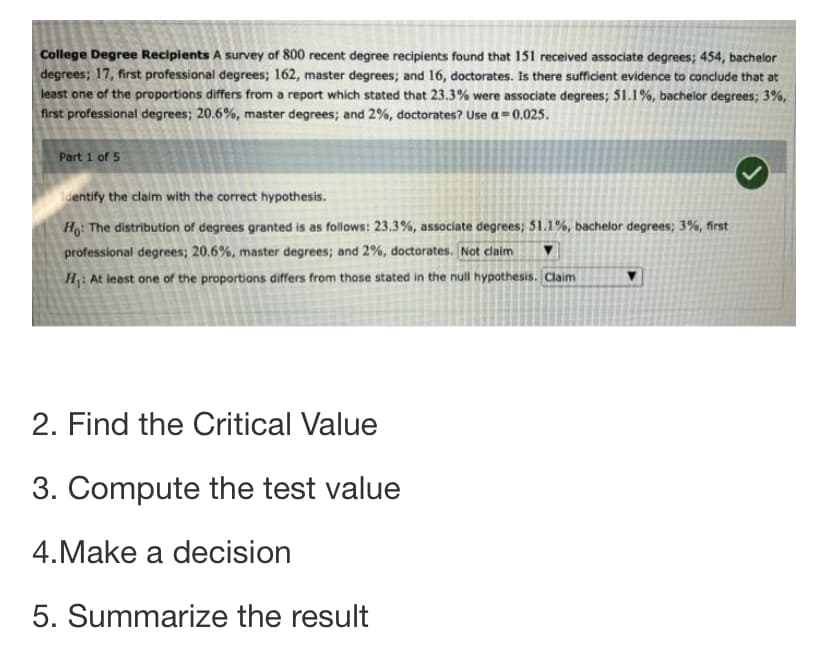College Degree Recipients A survey of 800 recent degree recipients found that 151 received associate degrees; 454, bachelor degrees; 17, first professional degrees; 162, master degrees; and 16, doctorates. Is there sufficient evidence to conclude that at least one of the proportions differs from a report which stated that 23.3% were associate degrees; 51.1%, bachelor degrees; 3%, first professional degrees; 20.6%, master degrees; and 2%, doctorates? Use a=0.025. Part 1 of 5 Identify the claim with the correct hypothesis. H: The distribution of degrees granted is as follows: 23.3%, associate degrees; 51.1%, bachelor degrees; 3%, first professional degrees; 20.6%, master degrees; and 2%, doctorates. Not claim H: At least one of the proportions differs from those stated in the null hypothesis. Claim
College Degree Recipients A survey of 800 recent degree recipients found that 151 received associate degrees; 454, bachelor degrees; 17, first professional degrees; 162, master degrees; and 16, doctorates. Is there sufficient evidence to conclude that at least one of the proportions differs from a report which stated that 23.3% were associate degrees; 51.1%, bachelor degrees; 3%, first professional degrees; 20.6%, master degrees; and 2%, doctorates? Use a=0.025. Part 1 of 5 Identify the claim with the correct hypothesis. H: The distribution of degrees granted is as follows: 23.3%, associate degrees; 51.1%, bachelor degrees; 3%, first professional degrees; 20.6%, master degrees; and 2%, doctorates. Not claim H: At least one of the proportions differs from those stated in the null hypothesis. Claim
Holt Mcdougal Larson Pre-algebra: Student Edition 2012
1st Edition
ISBN:9780547587776
Author:HOLT MCDOUGAL
Publisher:HOLT MCDOUGAL
Chapter11: Data Analysis And Probability
Section: Chapter Questions
Problem 8CR
Related questions
Question

Transcribed Image Text:College Degree Recipients A survey of 800 recent degree recipients found that 151 received associate degrees; 454, bachelor
degrees; 17, first professional degrees; 162, master degrees; and 16, doctorates. Is there sufficient evidence to conclude that at
least one of the proportions differs from a report which stated that 23.3% were associate degrees; 51.1%, bachelor degrees; 3%,
first professional degrees; 20.6%, master degrees; and 2%, doctorates? Use a=0.025.
Part 1 of 5
dentify the claim with the correct hypothesis.
H: The distribution of degrees granted is as follows: 23.3%, associate degrees; 51.1%, bachelor degrees; 3%, first
professional degrees; 20.6%, master degrees; and 2%, doctorates. Not claim
H: At least one of the proportions differs from those stated in the null hypothesis. Claim
2. Find the Critical Value
3. Compute the test value
4.Make a decision
5. Summarize the result
Expert Solution
This question has been solved!
Explore an expertly crafted, step-by-step solution for a thorough understanding of key concepts.
This is a popular solution!
Trending now
This is a popular solution!
Step by step
Solved in 2 steps with 1 images

Recommended textbooks for you

Holt Mcdougal Larson Pre-algebra: Student Edition…
Algebra
ISBN:
9780547587776
Author:
HOLT MCDOUGAL
Publisher:
HOLT MCDOUGAL

College Algebra (MindTap Course List)
Algebra
ISBN:
9781305652231
Author:
R. David Gustafson, Jeff Hughes
Publisher:
Cengage Learning

Holt Mcdougal Larson Pre-algebra: Student Edition…
Algebra
ISBN:
9780547587776
Author:
HOLT MCDOUGAL
Publisher:
HOLT MCDOUGAL

College Algebra (MindTap Course List)
Algebra
ISBN:
9781305652231
Author:
R. David Gustafson, Jeff Hughes
Publisher:
Cengage Learning